At ValidExamDumps, we consistently monitor updates to the Arcitura Education C90.06 exam questions by Arcitura Education. Whenever our team identifies changes in the exam questions,exam objectives, exam focus areas or in exam requirements, We immediately update our exam questions for both PDF and online practice exams. This commitment ensures our customers always have access to the most current and accurate questions. By preparing with these actual questions, our customers can successfully pass the Arcitura Education Cloud Architecture Lab exam on their first attempt without needing additional materials or study guides.
Other certification materials providers often include outdated or removed questions by Arcitura Education in their Arcitura Education C90.06 exam. These outdated questions lead to customers failing their Arcitura Education Cloud Architecture Lab exam. In contrast, we ensure our questions bank includes only precise and up-to-date questions, guaranteeing their presence in your actual exam. Our main priority is your success in the Arcitura Education C90.06 exam, not profiting from selling obsolete exam questions in PDF or Online Practice Test.
Cloud Service A and Cloud Service B perform different functions but both share access to Cloud Storage Device A when fulfilling requests from cloud service consumers that require data access.
Cloud Services A and B are hosted by Virtual Server A, which is hosted by Hypervisor A on Physical Server A.
Cloud Service Consumer A accesses Cloud Service A to issue a request for data (1). Cloud Service A queries a database in Cloud Storage Device A to retrieve the data (2). Upon receiving the requested data, Cloud Service Consumer A combines it with additional data to form a new collection of data. Cloud Service Consumer A then accesses Cloud Service B and provides it with the new data (3). Cloud Service B accesses a different database in Cloud Storage Device A to store the new data (4). Cloud Consumer B accesses the usage and administration portal to upload new data (5). The data is uploaded to Cloud Storage Device B (6).
Cloud Service Consumer A belongs to Organization A. Cloud Consumer B belongs to Organization B.
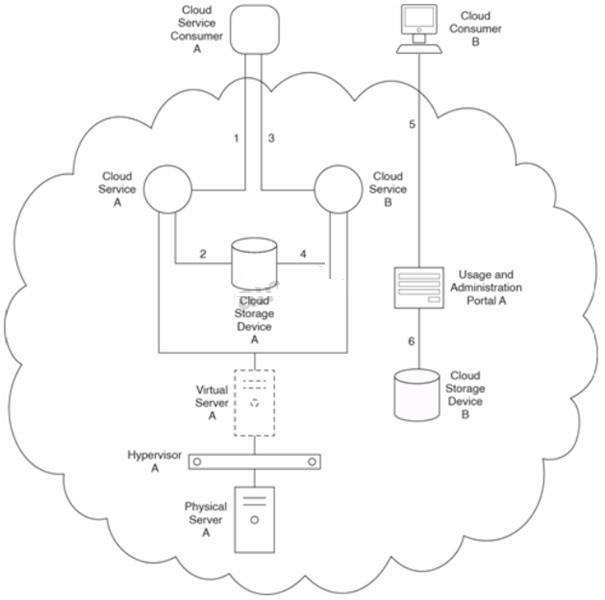
Cloud Service A is a SaaS product offered by the cloud provider to the general public, and is therefore used by numerous cloud consumers from different organizations at different times. Cloud Service B is also a SaaS product as part of the same overall solution as Cloud Service A.
However, because a given cloud service consumer only needs to access Cloud Service B when the data it receives from Cloud Service A meets certain criteria, it is not used nearly as much as Cloud Service A. Cloud Service A currently has a hard threshold allowing no more than 10 concurrent instances of it to exist at once. One day, Cloud Service Consumer A attempts to access Cloud Service A as the eleventh cloud service consumer, and is predictably rejected.
Cloud Service Consumer A belongs to Organization A, one of the cloud provider's most important customers. Therefore, when Organization A complains about not being able to access Cloud Service A during peak usage times, the cloud provider agrees to provide a solution.
As a result of a natural disaster, the cloud provider's data center that houses Physical Server A becomes unexpectedly unavailable. Physical Server A subsequently becomes unavailable for nearly two days. This outage exceeds what the cloud provider guaranteed in its original SLA and the cloud provider agrees to not charge Organization for usage fees for an entire month as compensation. However, the unavailability of Physical Server A had a significant impact on Organization As business, resulting in financial loss and loss of confidence of its clients.
Organization A informs the cloud provider that it cannot continue working with this cloud unless the cloud provider can guarantee that the availability of Physical Server A will no longer be dependent on a single data center or a single geographic region.
Organization B receives its latest monthly invoice from the cloud provider and discovers that the charges are identical to the invoice it received last month, even though the usage and administration portal shows that its data usage is a third less. They bring this issue to the attention of the cloud provider and are informed that they are currently subscribed to a fixed-allocation plan.
The cloud provider explains that in order to get them on a plan whereby they are charged only for actual data usage, Cloud Storage Device B would need to be upgraded and a system capable of tracking runtime usage would need to be established. Organization B asks the cloud provider to make these changes.
Which of the following statements provides a solution that can address Organization A's and Organization B's issues?
Cloud Service A requires access to Cloud Storage Device A and Cloud Storage Device B. Cloud Service A is hosted by Virtual Server A. Virtual Server A and Virtual Server B are hosted by Hypervisor A, which resides on Physical Server A.
Cloud Service Consumer A sends a request to access Cloud Service A (1). Cloud Service A retrieves data from Cloud Storage Device A and Cloud Storage Device B (2). Cloud Consumer A uses the usage and administration portal to access resource usage reports for Cloud Service A (3).
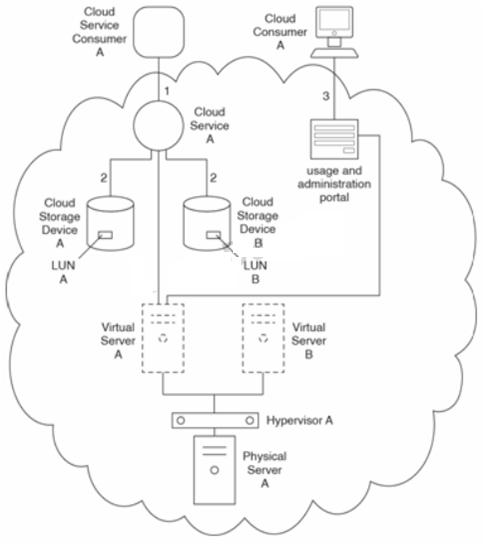
Cloud Service Consumer A and Cloud Consumer A belong to Organization A, which is leasing an laaS environment from the cloud provider.
The cloud provider makes Cloud Service A available to several new cloud service consumers.
Additionally, new LUNs are created on Cloud Storage Devices A and B for new cloud consumers to perform regular data access functions. This increase in workload causes Virtual Server A to fail during peak usage periods. Organization A and the new cloud consumer organizations request that the cloud provider find a way to dynamically support the higher usage workloads.
Organization A keeps its master files and data in LUN B in Cloud Storage Device B. One day, a cloud resource administrator accidentally changes the path used to access LUN B. The original path cannot be retrieved. The cloud resource administrator informs Organization A's IT department that it must change any systems or tools it uses to access LUN B to the new path.
This causes significant challenges, as well as a costly period of disruption. Organization A asks the cloud provider to create a system that would help avoid disruption in access to LUN B, if this was to ever happen again.
The cloud provider has made Cloud Storage Device A part of a resource pool of synchronized cloud storage devices. Organization A is sharing Cloud Storage Device A with another cloud consumer organization. When cloud consumers from both organizations access Cloud Storage Device A at the same time, they encounter a resource constraint condition that causes Cloud Storage Device A to fail. Organization A requests that the cloud provider extend the existing cloud architecture to prevent this situation from happening again.
Which of the following statements provides a solution that can address all of these problems?
Physical Server A hosts Hypervisor A which hosts Virtual Server A, Virtual Server B and an active cluster comprised of three virtual servers. Virtual Server A hosts Ready-Made Environment A. Ready-Made Environment A uses Cloud Storage Device A to store data related to the ready-made environment and its users. Cloud Service A is hosted by a high-availability (HA) virtual server cluster. Hypervisor A is a cluster-enabled hypervisor.
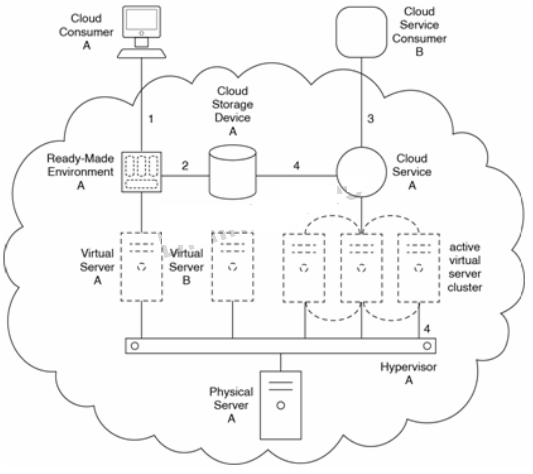
Developers access Ready-Made Environment A to work on the development of a new solution (1).
During this usage. Ready-Made Environment A regularly reads and writes data to Cloud Storage Device A (2). Cloud Service Consumer B accesses Cloud Service A (3). Cloud Service A queries data residing in Cloud Storage Device A in response to processing requests from Cloud Service Consumer B (4).
Hypervisor A is made part of a cluster of hypetvisors. Ready-Made Environment A, which is still hosted by Virtual Server Aon Hypervisor A, subsequently becomes unexpectedly unavailable. It then takes twenty minutes to pass before Virtual Server A and Ready-Made Environment A become available again on Hypervisor B (a hypervisor that is also part of the hypervisor cluster). This delay is considered unacceptable by Cloud Consumer A. Furthermore, after being relocated
to Hypervisor B, Virtual Server A is unable to connect to the network. By the time the cloud provider rectifies this second problem, Cloud Consumer A experiences a total of two hours of downtime.
Which of the following statements describes a solution that can minimize or entirely avoid a delay for the runtime relocation of Ready-Made Environment A?
Cloud Service A requires access to Cloud Storage Device A, which contains LUNs A and B. Cloud Service A is hosted by Virtual Server A, which resides on Hypervisor A on Physical Server A.
Virtual Server B hosts Cloud Service B and Cloud Service C.
Cloud Service Consumer A accesses Cloud Service A (1), which then accesses LUN A or B on Cloud Storage Device A (2). After receiving the requested data from Cloud Service A, Cloud Service Consumer A forwards the data to Cloud Service B (3), which then writes it to Cloud Storage Device B (4).
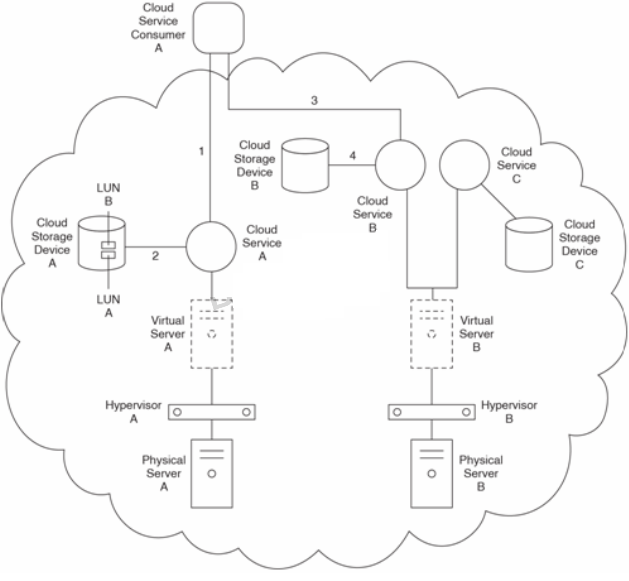
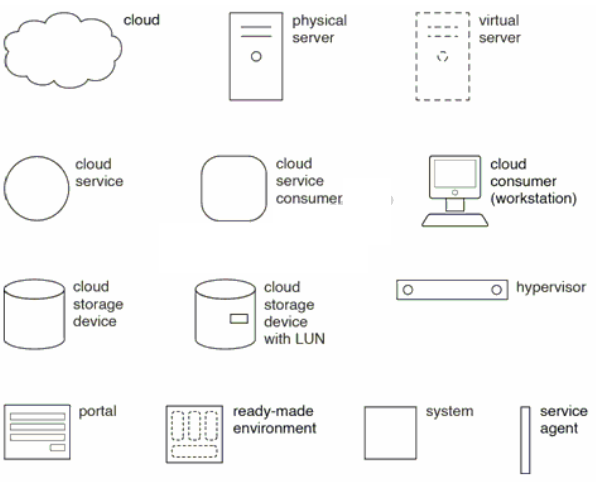
Cloud Service Consumer A belongs to Organization A,
Organization A uses LUN A and LUN B on Cloud Storage Device A to store their important client account data. Cloud Storage Device A is a low-performance cloud storage device, which begins to cause performance issues as more data is added to LUNs A and B and as Cloud Service Consumer A performs data access requests more frequently. Organization A asks that its cloud architecture be upgraded to process increased quantities of data and higher volumes of data requests.
Organization A has been leasing a PaaS environment that it used to build Cloud Service A, which it would like to make available to the general public. Organization A needs to establish a system capable of monitoring usage of Cloud Service A for billing purposes.
The cloud provider is using a usage data collection and reporting system that gathers information on Organization A's hosted IT resources approximately ten hours after the time of usage. One day, Organization A attempts to retrieve information on whether Virtual Server B has available Cloud Service C instances. They discover that they are unable to obtain the current status of Virtual Server B. Organization A demands a system that provides instant availability reporting.
Which of the following statements lists the patterns that can be applied to solve these three requirements and problems?
Ready-Made Environment A is hosted by Virtual Server A and Ready-Made Environments is hosted by Virtual Server B. Virtual Servers A and B are hosted by Hypervisor A, which is part of a hypervisor cluster. An automated scaling listener intercepts cloud consumer requests and automatically invokes the on-demand generation of additional instances of ready-made environments, as required.
A self-service portal and a usage and administration portal are also available to cloud consumers.
The self-service portal can be used to request the provisioning of a new ready-made environment.
Any cloud consumer that has already had a ready-made environment provisioned can configure and view information about that ready-made environment via the usage and administration portal.
Cloud Consumer A accesses Ready-Made Environment A to work on the development of a new cloud service (1). Cloud Consumer B accesses Ready-Made Environment B to test a recently completed application comprised of three cloud services (2). Cloud Consumer C accesses the self-service portal to request the creation of a new ready-made environment (3).
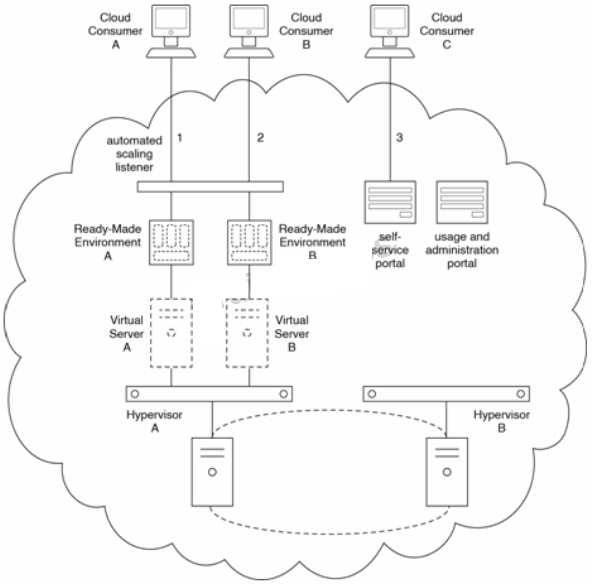
The cloud provider is required to perform an emergency maintenance outage on a cloud storage device used by all ready-made environments. The unplanned outage takes two hours. During this period, Cloud Consumers A and B are unable to access Ready-Made Environments A and B and Cloud Consumer C receives an error when submitting a request to create a new ready-made environment.
After the maintenance outage is over, Cloud Consumers A and B encounter the following problems:
Cloud Consumer A is unable to recover session data that was kept in memory for an extended period, prior to the time of the outage.
Cloud Consumer B has no access to Virtual Server B, which was moved to Hypervisor B during the maintenance outage. When Cloud Consumer B attempts to ping Virtual Server B, the request times out.
Even though Cloud Consumer C is able to log into the usage and administration portal to confirm that its ready-made environment was successfully provisioned, the unexpected outage has raised concerns about the stability of the ready-made environment's underlying infrastructure. Cloud Consumer C informs the cloud provider that it cannot proceed with its lease of the ready-made environment if there are future occurrences of this type of maintenance outage.
Which of the following statements can help address the problems and concerns of the three cloud consumers?